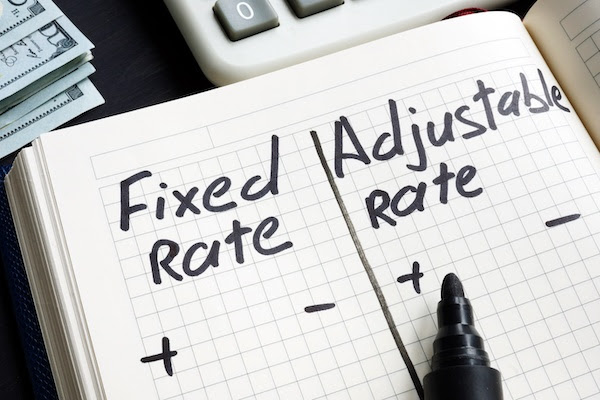The Pros and Cons of Adjustable Rate Mortgages
With mortgage rates climbing dramatically over the last year, many buyers are considering the pros and cons of an adjustable-rate mortgage (ARM) when purchasing a home. With a fixed-rate mortgage, the interest rate stays the same throughout the term of the loan, whereas with an adjustable-rate mortgage, the interest rate can change.
As you consider all your options, this guide may be helpful because these loans are more complex than their fixed-rate counterparts.
 What are ARM Loans?
What are ARM Loans?
An adjustable-rate mortgage (ARM) starts out fixed and then changes to an adjustable rate after a short period of time. During the first three to ten years, you’ll pay a fixed interest rate that is lower than what you’d get with a fixed-rate mortgage. Once this initial period has ended, the interest rate will fluctuate at different intervals.
When you’re approved for the mortgage, you’ll discover how often your interest rate will change after the initial fixed period. If you obtain a 10/6 ARM, the fixed interest rate will last for 10 years, after which your interest rate will change every six months. A 7/1 ARM, on the other hand, has a fixed rate for seven years before switching to an adjustable rate that changes once a year. Market conditions determine whether your rate increases or decreases.
Pros of ARMs
It is important to note that adjustable-rate mortgages provide a number of benefits, including low monthly mortgage payments during the initial fixed-rate period. During this period, you are able to increase your savings before interest rates change, regardless of whether it lasts three years or seven years. It should also reduce your stress levels to have predictable payments after you purchase a home.
Also, buyers who aren’t looking for their forever home yet might be interested in these loans. During the fixed-rate period, you could sell your property without having to worry about the adjustable-rate period if you anticipate relocating, changing jobs, or upgrading to a bigger home in a few years. The interest rate on these loans is limited, and once the initial fixed-rate period is over, interest rates may fall.
Cons of ARMs
One of the risks with ARMs is that your monthly mortgage payments can easily increase. Once the adjustable period begins, your monthly mortgage payments will go up if interest rates rise nationally.
It’s also possible that not everything will go according to plan. Life happens. When interest rates rise, you may find yourself in a situation where you can’t make your monthly payments.
You need to consider a lot when deciding which type of home loan is right for you. Despite the lower initial interest rate on an adjustable-rate mortgage, your monthly payments will become unpredictable after the fixed period is over. Many people find this unpredictability not worth the savings. Before making a final decision, your lender can explain all the loan options available to you, so that you have all the information you need.
Remodeling and renovating your home could decrease its value. Homeowners across the U.S. are expected to spend $400 billion on remodeling and renovating their homes by 2020. Most people believe that home improvement projects will increase their resale value. In reality, there are several home improvement projects that could decrease the value of your home.
Constant Carpeting
Hardwood floors should not be covered with wall-to-wall carpeting if your home has hardwood floors. When a carpet isn’t in perfect condition, most buyers would prefer it to be removed, which is why carpeting doesn’t add value to a home.
A study by the National Association of Realtors found that hardwood flooring projects have a cost recovery rate of 118%. This means you could increase your property’s value as much as $17,700 by installing new wood flooring for $15,000.
Adding a Swimming Pool
It costs anywhere between $16,000 and $44,000 to build an outdoor swimming pool, which doesn’t take into account ongoing maintenance costs. Swimming pools do not add much value to a home unless you live in a hot climate. Approximately 7% of homes are valued by swimming pools. Prospective buyers might also be frightened off by the potential liability associated with swimming pools.
Converting Your Garage into a Living Space
It can cost anywhere from $6,000 to $24,000 to convert your garage into a living space. While this conversion will increase your home’s functionality and square footage, most buyers prefer the original garage space for storage and easy parking.
Excessive Landscaping
It is easy to make too many changes to your landscaping, which could result in an unattractive and cluttered appearance. Landscaping your home can significantly improve its curb appeal, making it more appealing to potential buyers. Buyers may perceive your yard as difficult to maintain if you make too many changes. If you want to appeal to the majority of buyers, keep it simple and clean.
Too Much Wallpaper
Using the wrong color scheme or pattern may result in a thinning of the pool of potential buyers, even though wallpaper doesn’t necessarily turn buyers away. Depending on the size of the room, the type of wallpaper you use, and whether you DIY or hire a professional, wallpaper installation projects can cost from $300 to $6,000.
While these costs are not that high compared to other projects in this guide, removing wallpaper is a costly and time-consuming job, which may make some potential buyers think twice when they first see a room with wallpaper they don’t like. Performing the wrong renovation on your home could result in your property becoming less appealing to prospective buyers. This could mean fewer offers or even lower sales prices. If you want your renovations to increase your home’s value, remodel the kitchen/bathroom areas, upgrade the appliances, or contact me and I can tell you which features have the best return on investment.


 Facebook
Facebook
 X
X
 Pinterest
Pinterest
 Copy Link
Copy Link


